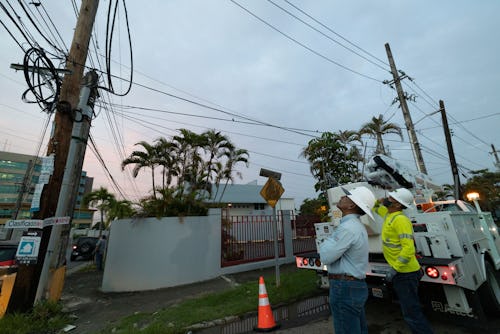Puerto Rico’s major blackout raises concerns about hurricane season
More than a million people were left without power on the island after a power plant failure this week.

When it comes to climate change, a single, apoplectic event isn’t the real cause for concern. We’re probably not going to live through the movie 2012. Instead, it’s the long-term impact of climate disasters that strike year after year, leaving people with no time for recovery, that pose the greatest threat. That much is illustrated in Puerto Rico where a major power outage poses concerns about the potential devastation of this year’s hurricane season.
On Thursday, a fire that took place at the Costa Sur generation plant — one of only four power plants on the island — caused the biggest blackout so far this year. It left over a million Puerto Ricans without electricity and about 160,000 people without water. Per the Associated Press, Luma, which took over the island’s grid from the Electric Power Authority last year, said the blackout could’ve been due to a circuit-breaker failure.
If you haven’t lived through an extensive blackout, it may be hard to understand the risks. But ensuring that people have access to safe food is an obvious concern. While some in Puerto Rico have generators as backups, not everybody can afford one. AP reported that in at least one city, officials have distributed food to hundreds of elderly people along with ice for those who need to keep their medications cold.
As for a timeline for when Puerto Ricans will regain power, Kevin Acevedo, a vice president of Luma, told AP that the company hopes to bring it back within 24 hours. However, Acevedo cautioned, “The people of Puerto Rico have to understand that it’s a system with a lot of years. Bringing back Puerto Rico’s system is a delicate and complicated process.”
The exact cause of that failure is unknown. Acevedo told AP, “It’s going to require an exhaustive investigation.” But a series of earthquakes that hit southern Puerto Rico, where the Costa Sur plant is located, may be part of the problem. In addition, Puerto Rico’s infrastructure is still severely damaged by 2017’s Hurricane Maria, which left $90 billion worth of destruction in its wake.
In September 2021, NBC News reported that Puerto Rico still hadn’t started its reconstruction efforts. While Congress directed $63 billion for disaster relief and recovery operations, about 71% of funds hadn’t reached Puerto Ricans at the time, according to FEMA’s Recovery Support Function Leadership Group. Then, Rep. Nydia Velázquez (D-N.Y.) warned at a press conference, “If a hurricane today, Category One, hits the island, it will not survive. The power grid will not survive.”
"Puerto Ricans are experiencing blackouts almost daily and every single one of those blackouts takes them back to that unforgettable dawn of September 2017,” Velázquez continued. “Thousands of houses with blue tarps. That is happening in America.”
This blackout comes just two months before hurricane season. Recently, AccuWeather predicted that 2022 will be the seventh straight above-average Atlantic hurricane season. Between three to five major hurricanes with sustained winds of at least 111 miles per hour are expected to form. In addition, AccuWeather reported there’s “a higher-than-normal chance that a major hurricane could make landfall in the mainland United States, Puerto Rico, and the U.S. Virgin Islands.”
Hurricane Maria reached sustained winds of 175 mph. But even if there isn’t a hurricane this year that will match its power, that doesn’t mean Puerto Rico is in the clear. The devastation wrought by Maria — and the failures of the federal government to appropriately respond — have left the island increasingly vulnerable heading into the 2022 season.